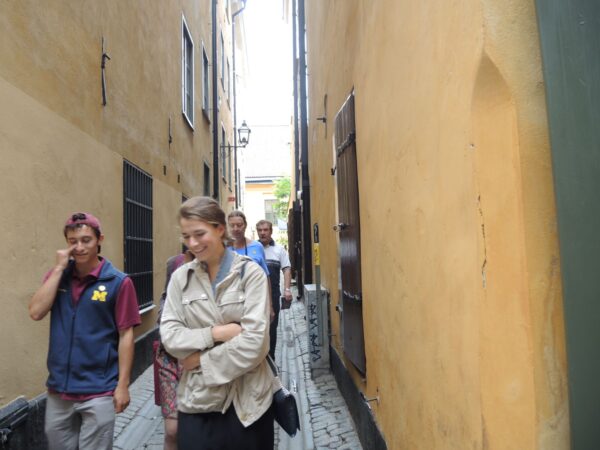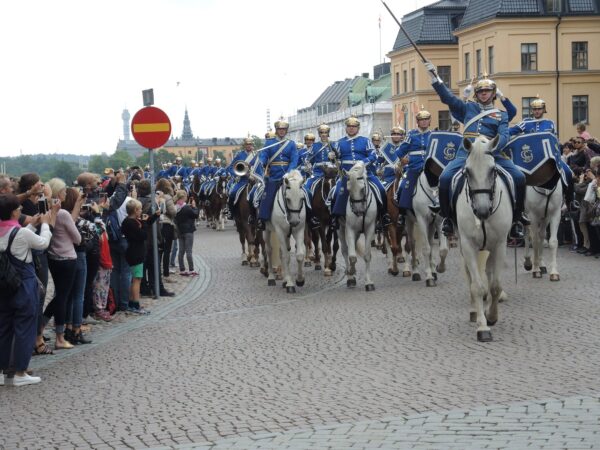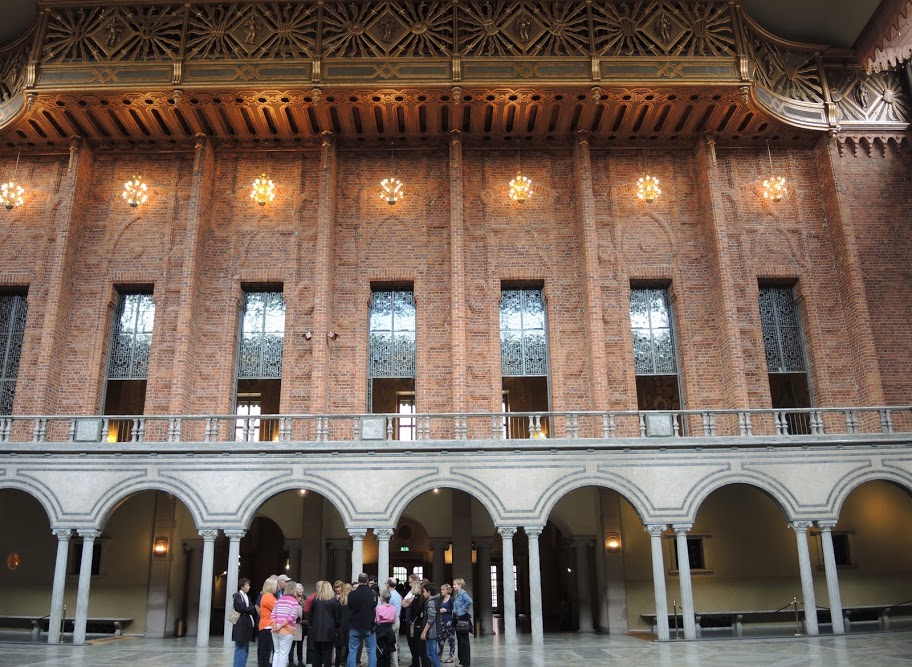Stockholm and Nobel.
As it does in Norway, Stockholm’s city hall serves more than merely an administrative purpose. It sits along the banks of lake Mälaren – a 160-kilometer-long freshwater lake that stretches from the Baltic far to the west of the country. City Hall is among the most visited tourist attractions in the city and is, as noted in part one, probably most well-known for hosting the Nobel Prize banquet that’s held in the Blue Hall.
This space can hold up to 1,200 people and can be rented for other events. If you’re curious about the absence of blue, here’s the explanation: The building’s architect, Ragnar Östberg, originally planned to plaster the walls and paint the plaster blue to evoke the lake just outside. When he saw the red brick, he changed his mind and left that in place but the term “Blue Hall” was already widely used and never changed.
In the center of the photo, you see a series of openings. These lead to the even more impressive Golden Hall with its 18 million pieces of gold mosaic that depict scenes from Stockholm’s history. The most extraordinary, and quite probably the most meaningful of these to the Swedes themselves, is the depiction that covers the entire north wall of the hall. It is of the Queen of Mälaren (one of the city’s nicknames) receiving gifts from the east and the west.
On a side note, the first two Nobel Prize ceremonies in 1901 and 1902 were attended exclusively by men. The reason this changed in 1903 is a straightforward one. Three people – two men and one woman – who had discovered and researched spontaneous radioactivity shared that year’s prize for physics. The men were Antoine Henri Becquerel and Pierre Curie. The woman was, of course, Marie Curie who would go on to win a second Nobel Prize in chemistry eight years later becoming the first person, the only woman, and one of only six multiple Nobel Prize winners – four individuals plus two organizations.
As we move on to some of the narrow streets of Gamla Stan or Old Town,

I’ll note that in 2010, Stockholm was named the first “green” capital in Europe by the EU Commission and was considered the city most free from pollution. One reason for this is that the city has an integrated administrative system that ensures the inclusion of measures of the environmental impact in planning of all major projects and assures that continued monitoring and reporting are a part of the ongoing operational budget. In the quarter century leading up to the award, the city cut its carbon dioxide emissions by 25 percent and formally established a goal of being fossil fuel free by 2050.
Expressing my feeling that Stockholm is the most beautiful of the Scandinavian capital cities, I noted “the amount of green space the city incorporates.” Here are the raw numbers. The city is surrounded by 219 nature reserves, has nearly 1,000 green spaces comprising about one-third of the city’s area and established the world’s first legally protected national urban park, the Royal National City Park, in 1995.
In part one of this post, I mentioned that Birger Jarl is often considered the person who founded Stockholm and there’s an interesting legend that accompanies that event. Sweden’s oldest town, Sigtuna, was established in 980 and was the original capital of the country. It was also a commercial center with a proximity to a nearby medieval royal estate Uppsala Öd. When the city found itself under fairly constant attack, a perceived need to relocate the capital arose. Legend has it that the leaders of the town hollowed out a log, filled it with gold and set it afloat on the water until it eventually hit the land where Gamla Stan is located today.
In truth, the location was likely chosen because as an island it was relatively easy to defend. It also had the advantage of sitting more or less at the junction of Lake Mälaren and the Baltic. The lake and the sea were both critical to trade at the time. Though called Gamla Stan today, the island was originally called Stockholm which translates roughly as “log island” or “the place where the log hit the ground.” As the city expanded, the island became known as Staden mellan broarna or “The Town between the Bridges.” It carried this name until 1980 when it officially became Gamla Stan. Personally, I prefer Staden mellan broarna.
You might recall that in a previous entry from my time in Norway I mentioned the “Stockholm Bloodbath” that took place over the course of three days in November 1520 when King Christian II of Denmark had more than 80 members of the Swedish nobility and clergy beheaded. The picture above is of Storgorget the large square near the center of Gamla Stan where the massacre occurred. The light-colored building partially visible in the upper left corner of the picture is the Nobel Museum.
This building was originally constructed as the Stock Exchange Building in the last quarter of the 18th century. It became the site of the Swedish Academy, which names the winner of the Nobel Prize for Literature, in 1914. It would be ironic, would it not, if this, rather than Oslo, were the site of the announcement of the Peace Prize. (Behind the water pump in the top center of picture is the Grillska Huset Café – a restaurant run by the Stockholm City Mission. I plan to have lunch there tomorrow.)
One observation I’ve made, particularly in the large cities, is that the Scandinavian countries are not nearly as homogeneous as I had imagined them. In part, this might be because the timing of my visits coincided with the time that many Scandinavians are traveling and using part of the five weeks of nationally mandated vacation. Certainly, the absence of Norwegians or Danes or Swedes would contribute to my sense that these cities and countries have a larger immigrant population than may be the case.
But immigration is clearly changing these countries. And, as clear evidence of that, I will eat my lunch today at a restaurant that serves a Swedish-Italian menu but that is owned and managed by a family of Lebanese transplants.
One final (and I presume coincidental) highlight of our walk through the Old Town was, that as we approached its end, we happened to be in the square for the Changing of the Guard. We jostled through the rapidly assembling crowd to watch the parade start but couldn’t stay to observe the entirety of the circumstance and pomp.

After the morning’s bus tour, we could choose to disembark in Djurgården – the island in central Stockholm that’s among the city’s favorite recreation areas attracting more than ten million visitors annually – or return to the hotel. Needless to say, I chose Djurgården and I’ll cover my afternoon activities in my next report.


